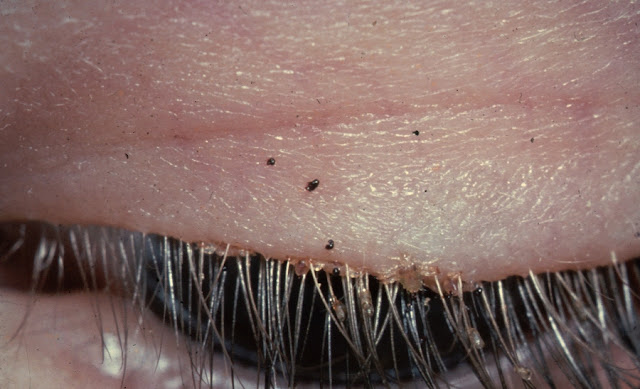Lice ( Pediculus Humanus Capitis ) are tiny, wingless, parasitic insects that are highly contagious and spread by close personal contact and by sharing belongings.They feed on human blood.
There are three types of lice:
1.Head Lice :
These lice are found on your scalp. They're easiest to see at the nape
of the neck and over the ears.An infestation of head lice most often
affects children and usually results from the direct transfer of lice
from the hair of one person to the hair of another.
2.Body Lice :
These lice live in clothing and on bedding and move onto your skin
to feed.Poor hygiene and ovecrowded people are most often affected by Body lice.Body lice are known to transmit Epidemic Typhus, Relapsing Fever and Trench Fever, diseases caused by Rickettsia prowazekii, Borrelia recurrentis and Bartonella quintana,
respectively.
3.Pubic Lice :
These lice occur on the skin and hair of the pubic area and less frequently on chest hair, eyebrows or eyelashes.
Bite Of Lice :
They bite anywhere they are feeding on the head, but they are particularly fond of the back of the head and the area behind the ears because this is a warmer area of the scalp. The bites often appear as small reddish or pink bumps, sometimes with crusted blood. When scratched excessively, the bites can become infected.
Lice Or Dandruff :
Lice lay eggs called nits while dandruff causes flaky skin. The two look similar,but close inspection reveals key differences. Nits stick to the hair while dandruff flakes, easily falling off of hair. While dandruff is visible on the scalp, lice lay eggs on hair, not the scalp.
What are the Problem of Lice you feel :
Lice can cause symptoms, such as:
1.Intense itching on the scalp, body or in the genital area.
2.A tickling feeling of something moving on your head, hair or body.
3.Sores that develop from scratching itches on the scalp, neck and shoulders.
4.Lice on your scalp, body, clothing, or pubic or other body hair.
5.Lice eggs (nits) on hair shafts.
6.Irritability.
7.Difficulty sleeping.
8.Red bumps on your head, neck, shoulders, or pubic area.
How do you know it's Lice:
The diagnosis of head lice infestation is best made by finding a live nymph or adult louse on the scalp or hair of a person.If crawling lice are not seen, finding nits attached firmly within ¼ inch of the base of hair shafts suggests,but does not confirm, the person is infested.
How do you Get Rid of Lice:
1.Prescription treatments include Malathion, Lindane,Benzyl Alcohol, Ivermectin, and Spinosad as per Doctor Advice.
2. Wet combing is one technique. You simply wet the hair and use a fine-tooth comb to remove active lice and their eggs. You'll need to do this every week for at least 3 weeks.
3.You can suffocate and kill lice using greasy substances like Petroleum jelly, Mayonnaise, or Olive oil.
How do you Control Lice :
1.Avoid head-to-head (hair-to-hair) contact during play and other activities at home, school and elsewhere (sports activities, playground, slumber parties, camp).
2.Do not share clothing such as hats, scarves, coats, sports uniforms, hair ribbons, or barrettes.
3.Do not share combs, brushes, or towels.
People can have good personal hygiene and still get lice.Unless treated properly, this condition can become a recurring problem.
#lice, #nasrennipa







0 Comments
if you have any doubt,please let me know